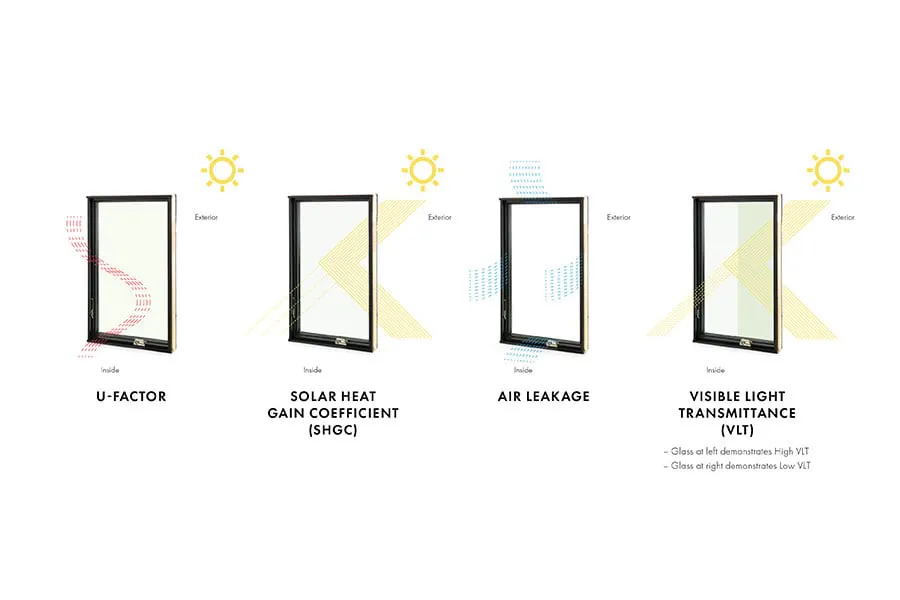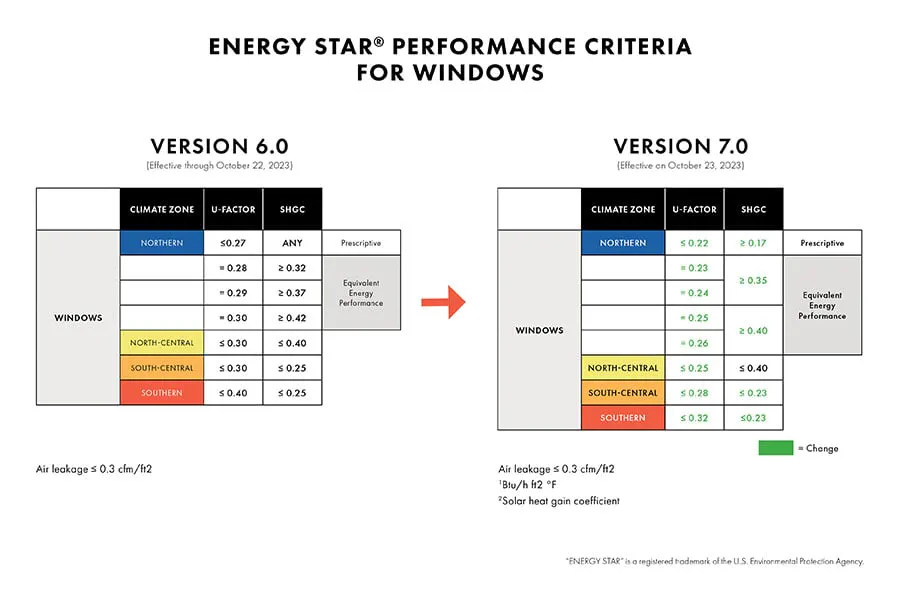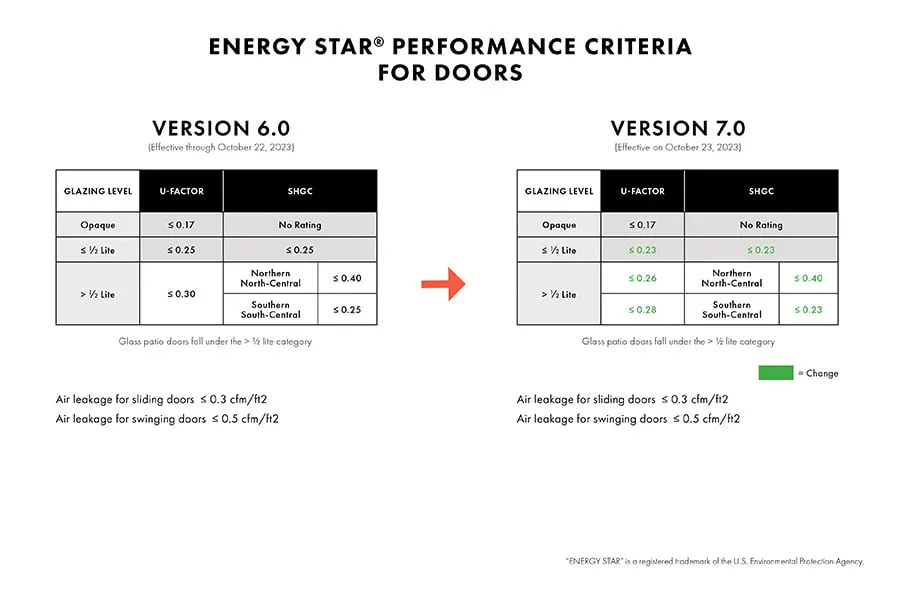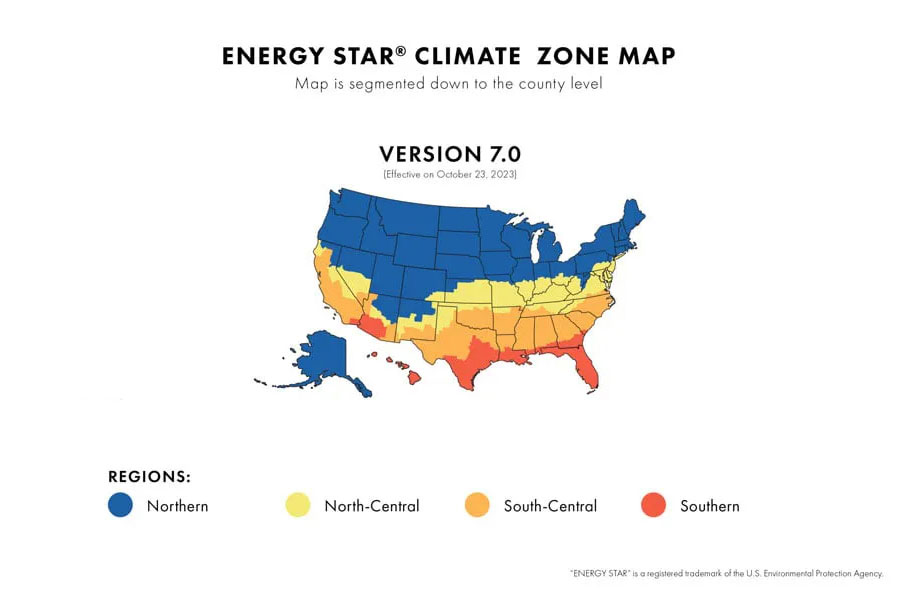With an extensive window design and engineering background, Cliff MacDonald, a Product Manager at Andersen, provides product insight to help create the best product and service experience possible. With a focus on Specialty doors, installation, joining, and energy performance, Cliff strives to make it easy for builders, dealers, and installers to be successful.
We asked MacDonald to share with us what’s changed in the new 7.0 version of ENERGY STAR® and how that impacts product specifications by climate zone.
Let’s start with the basics. How does ENERGY STAR® v. 7.0 compare to the previous version, 6.0?
The U.S. Environmental Protection Agency (EPA) published the new 7.0 standard in late 2022 and it went into effect in October of 2023. The requirements for meeting ENERGY STAR v. 7.0 criteria are much more stringent now than they were in v. 6.0, particularly for the Northern and North-Central climate zones.
The difference mainly has to do with the U-Factor, which measures energy efficiency. How well insulated are the windows, doors and skylights, and how much heat transfer do they allow? Obviously, the optimal U-Factor depends on the climate, but the thing to keep in mind is the lower the U-Factor value, the better insulated the unit is. That depends on all the components and how much conduction and heat energy they allow as a unit.
In addition, the county-level climate zone designations on the U.S. map have changed slightly since version 6.0.
It’s important to remember that ENERGY STAR certification is different from local energy codes, which must be complied with. ENERGY STAR compliance is voluntary, but in addition to helping lower homeowner energy costs for heating and cooling, using these products in their homes can help them qualify for environmental tax credits.

How is energy efficiency calculated?
U-Factor values are measured in British Thermal Units (BTUs) per hour square foot degree Fahrenheit [BTU / hr x ft2 x °F]. They range from 1.2 — poor performing — down to 0.20 or even lower, which are best performing. The lower the U-Factor, the more energy efficient the home will be. There are other ways to measure energy efficiency: SHGC, which is solar heat gain coefficient; air leakage, which refers to the airtightness of the assembly itself, but is not a function of any flaws that might occur in installation; and VLT, or visible light transmittance, which can be influenced by Low-E glass coatings.
The two primary factors that contribute to ENERGY STAR v. 7.0 compliance are the U-Factor and the SHGC. A product with a higher U-Factor can be balanced by a better SHGC rating. However, it should be mentioned that a lower SHGC rating is better for warmer climates and a higher rating is better in cooler ones. The lower rated products are better at blocking heat from the sun and the higher rated ones do a better job of admitting solar energy in the wintertime.
Can you tell us more about the ENERGY STAR® v. 7.0 changes by climate zone?
The Northern climate zone now has the toughest criteria ever, with a U-Factor of less than or equal to 0.22 for windows and 0.26 or less for patio doors. Also for the Northern zone, there’s a minimum SHGC requirement for windows of 0.17 or greater. The thing to know is that for the Northern climate zone, the easiest way to comply with version 7.0 is with a triple-pane product like our A-Series windows.
The North-Central climate zone’s U-Factor certification requirement has also dropped significantly, from 0.30 or less as it was in version 6.0 to a rating of 0.25 or less in version 7.0. In the Southern climate zone, there’s also been a big drop in the U-Factor rating requirement from 0.40 or less down to 0.32 or less. The South-Central region also saw a drop, but not one as dramatic as for some of the other zones.
In the North-Central, South-Central and Southern climate zones, dual-pane windows and doors with SmartSun™ glass and HeatLock® technology will help meet the version 7.0 requirements.
The biggest geographical changes in climate zone designations occurred in the western states of California and Nevada, but there are tweaks all over the map, so it’s important to research what climate zone you’re working in. You can look that up here: ENERGY STAR website.
What about window and door construction? Are there different recommendations by climate zone to meet performance requirements?
A triple-pane product is your best bet in any climate zone to meet stricter performance requirements. That’s especially true for patio doors. When one of Andersen’s enhanced glass options are selected, both gliding and hinged patio doors with triple pane glass can meet the version 7.0 performance criteria, allowing for greater customization without any compromise on performance. Dual-pane windows and doors can also work in any zone with the right glass option. In either case, a gas fill within the space between the panes enables improved energy efficiency.
Triple pane glass offers an additional layer of Low-E coating that can be applied, which offers more energy efficiency.


Besides glass, what other product features can affect energy performance?
The window type, for one thing. Awning, casement and picture windows are typically more energy-efficient than double- or single-hung windows. That’s because picture windows are fixed in place, and awning and casement windows seal tighter when there’s wind blowing against them.
Grilles are not recommended. Grilles decrease energy efficiency because they take away from the air space between the panes and actually conduct energy. We offer a full divided light grille option with an energy spacer with our A-Series windows and patio doors. The interior and exterior grille are permanently applied with a narrow spacer bar that doesn’t make contact with the glass, so they provide the look of a grille without the drawbacks.
Breather tubes are a feature intended to keep windows and doors from becoming overly pressurized in high altitude locations by allowing air to pass between panes. These are required in homes at elevations of 4,000 feet or more above sea level, but they increase the U-Factor of units. Consideration should be given to other options to mitigate the effect of the tubes.
How can builders know if the windows and doors they select are ENERGY STAR v. 7.0 compliant?
The U.S. government has stringent requirements about when manufacturers are permitted to advertise their products as version 7.0 compliant. This requires laboratory testing and certification by bodies recognized by the EPA for windows, doors and skylights.
We offer a variety of customization options and will help you make sure the products you choose are both aesthetically pleasing and meet ENERGY STAR® v. 7.0 performance requirements.
For more information, visit andersenwindows.com.








